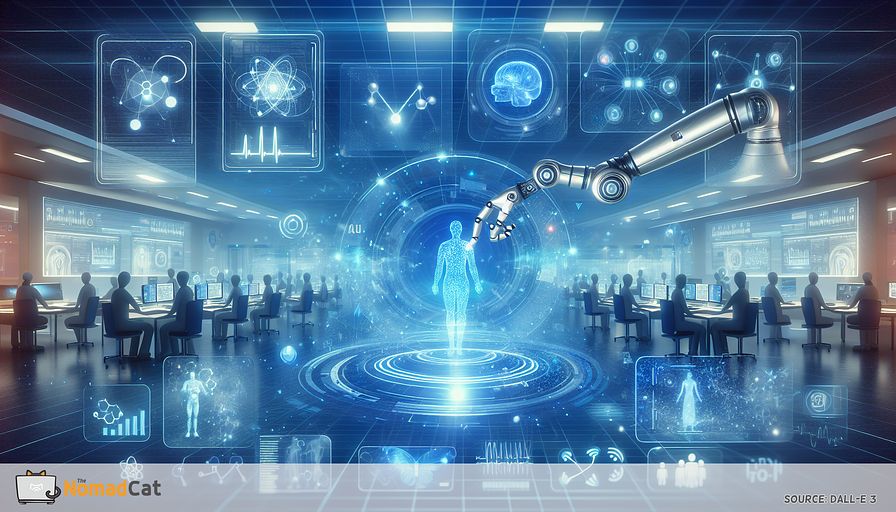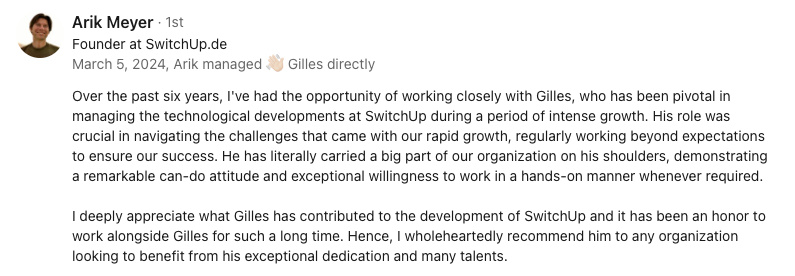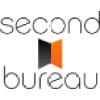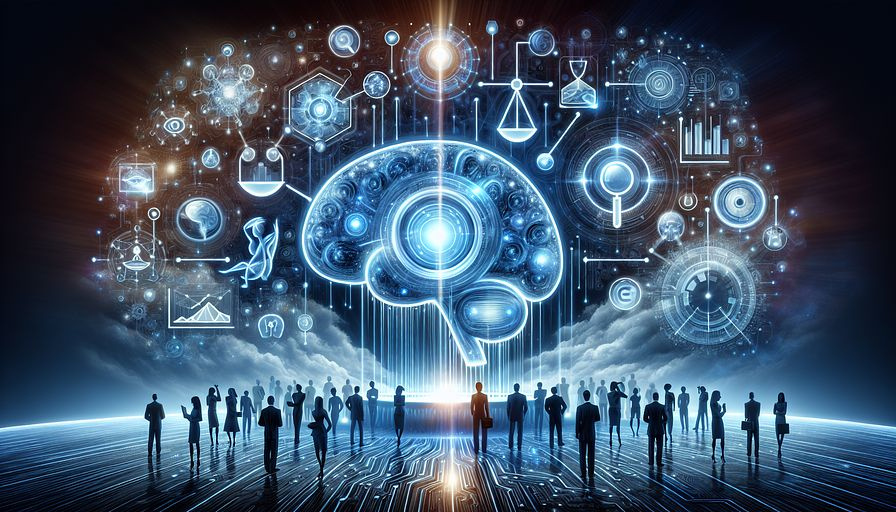Redefining Care: Datafication's Impact in Healthcare
Abstract:
The Chief Technology Officer discusses the impact of datafication on patient care, highlighting advanced technologies like AI and IoT. These technologies enable predictive models and real-time data insights, revolutionizing healthcare. Directors of Technologies and Engineering play a crucial role in implementing these technologies for improved patient outcomes. However, challenges such as data privacy and interoperability must be addressed. Embracing datafication has the potential to enhance patient care and drive the industry towards a new era of data-driven healthcare.
intriguing introduction
As a Chief Technology Officer, I've seen a lot of buzzwords fly by, but none quite as impactful as "datafication." It's not just a fancy term; it's a seismic shift that's transforming patient care as we know it. Picture this: through sophisticated data algorithms, healthcare providers can predict illnesses before they even strike. Sounds like something out of a sci-fi movie, right? Yet, this is the reality we’re building, and it's every bit as fascinating as it sounds.
From artificial intelligence (AI) to the Internet of Things (IoT), the possible applications of advanced technologies in healthcare are boundless. The ability to analyze massive amounts of data allows us to provide care that is more personalized, efficient, and proactive. Suddenly, the focus shifts from reactive treatments to preventing conditions before they even surface.
Let’s break this down further to explore how these predictive models work and why the role of Directors of Technologies and Engineering is more critical than ever. Trust me, the future of healthcare is looking brighter and more data-driven than ever. And yes, I promise it’s not all work and no play even in the tech-driven world of medicine!
```htmladvanced technologies and predictive models
When we talk about the transformative power of data in healthcare, it is crucial to spotlight the technologies driving this change. Artificial intelligence (AI) and the Internet of Things (IoT) are at the core of what I like to call the "datafication revolution." These are not just buzzwords; they are the linchpins enabling predictive models and real-time data insights that make a tangible difference in patient outcomes.
artificial intelligence: the brain behind the data
AI is not merely a Hollywood trend; it’s a game-changer for healthcare. Through machine learning algorithms, AI can process vast amounts of health data faster than any human ever could. This isn't just about speed but also precision. By analyzing complex datasets, AI can identify patterns and anomalies that might elude even the sharpest human mind.
For instance, consider cancer diagnosis. Traditional methods involve several tests and waiting time, which can be agonizing for patients. With AI, we can analyze medical imaging far more quickly and accurately. A study published in the journal Nature highlighted how an AI system outperformed radiologists in identifying breast cancer from mammograms. This technology can also predict the likelihood of cancer recurrence, giving doctors and patients a head start on preventive care plans.
the internet of things: connecting the dots
Meanwhile, IoT refers to a network of interconnected devices that can collect and exchange data in real-time. In healthcare, think of wearable devices like smartwatches or fitness trackers. These gadgets measure everything from heart rate to sleep patterns, providing a continuous stream of data that can be incredibly useful for both patients and doctors.
One compelling example is remote patient monitoring (RPM). Through IoT devices, patients with chronic conditions like diabetes or heart disease can constantly send data to healthcare providers. This real-time monitoring can alert doctors to any abnormal readings, prompting immediate intervention. This way, a potential crisis can be averted before it spirals out of control.
predictive analytics: a crystal ball for healthcare
But it’s not just about collecting data; it’s about making sense of it. That's where predictive analytics enters the picture. By leveraging AI and IoT, we can create predictive models that anticipate health issues before they become severe. Imagine a world where a slight change in your blood pressure reading could warn you of a potential heart attack days in advance. Seems futuristic, but it’s happening now.
In a recent project, my team worked on developing a predictive model for sepsis, a life-threatening response to infection. Traditionally, sepsis is detected too late because its symptoms can mimic other less severe conditions. By analyzing various data points like vital signs, lab results, and even patient history, our model can predict the likelihood of sepsis development, allowing for quicker and more effective treatment.
tangible improvements backed by data
So, what are the tangible outcomes of these technologies? Flexibility, efficiency, and a more personalized approach to healthcare. We’ve moved from a one-size-fits-all methodology to what can only be described as bespoke medical care. This shift is backed by solid data.
- Reduced hospital readmissions: Predictive models can identify high-risk patients, allowing for better follow-up and reduced readmissions. For example, a hospital in Pennsylvania implemented a predictive analytics model that reduced readmissions for heart failure patients by 26%.
- Enhanced patient engagement: IoT devices and AI not only improve patient outcomes but also empower patients to take control of their health. Mobile apps connected to IoT devices encourage patients to stick to treatment plans and stay informed about their health metrics.
- Cost savings: By preventing conditions before they escalate, these technologies save significant costs for both healthcare providers and patients. A study showed that AI-driven predictive analytics save hospitals an estimated $21 million annually by preventing adverse events and optimizing resource allocation.
So, while the technologies might sound a bit overwhelming, the improvements they bring are far from abstract. Thanks to AI and IoT, we're not just reacting to health issues but proactively managing them. And that, in essence, is what datafication aims to achieve – a smarter, more connected, and ultimately healthier world.
``` ```htmlrole of directors of technologies and engineering
Ever wondered who the unsung heroes behind the integration of advanced data technologies in healthcare are? Meet the Directors of Technologies and Engineering. These individuals stand at the confluence of innovation, strategy, and healthcare delivery. They’re the conductors of the complex symphony that is datafication in healthcare, ensuring that all components operate in harmony to produce life-saving outcomes.
navigating the complexities
The job is no small feat. Directors of Technologies and Engineering are responsible for seamlessly integrating cutting-edge technologies like AI and IoT within existing healthcare frameworks. It's a bit like adding the latest software update to an ancient operating system—without causing the system to crash. They need to ensure interoperability, security, and compliance with stringent healthcare regulations while pushing the envelope of what's technically possible.
Imagine juggling multiple flaming torches while riding a unicycle on a tightrope—that’s pretty much what they do. They need to balance the demands of healthcare professionals, patients, and regulatory bodies, all while keeping an eye on the technological horizon. The stakes are high, but so are the rewards when everything falls into place.
real-world successes
Let’s talk success stories, shall we? One shining example is the Mayo Clinic’s adoption of an AI-driven diagnostic tool. Directors of Technologies and Engineering at the Mayo Clinic spearheaded the integration of machine learning algorithms to analyze medical images. The outcome? A significant reduction in diagnostic errors and a speedier process, improving patient care and clinician efficiency.
Another remarkable case is the Cleveland Clinic’s deployment of IoT devices for remote patient monitoring. Here, smartwatches and biosensors are given to patients with chronic illnesses to continuously monitor vital signs. The real-time data feeds into a centralized system, where AI analyzes it for signs of trouble. This initiative cut down emergency room visits and hospital readmissions by almost 30%. The directors behind this project have demonstrated how leveraging IoT can lead to substantial improvements in patient outcomes and operational efficiency.
challenges on the road
Now, it’s not all roses. These directors face numerous challenges. One major hurdle is data security. With great data comes great responsibility. Ensuring the confidentiality and integrity of patient data is paramount. Cybersecurity threats are ever-present, and directors must constantly stay ahead of these risks through robust encryption, regular audits, and continuous monitoring.
Another challenge is user adoption. It’s no secret that healthcare professionals aren’t always thrilled about new technologies—especially those that alter their work routines. Directors must foster a culture of innovation and provide adequate training and support to ensure smooth transitions. It's a bit like coaxing a cat into a carrier: a mix of patience, persuasion, and perhaps a few treats!
best practices
So, how do they make it all work? Here are a few best practices gleaned from successful implementations:
- Collaborative approach: Directors actively engage with clinicians, nurses, IT staff, and even patients to understand their needs and gather feedback. This collaborative approach ensures that the technology solutions address real-world problems and are user-friendly.
- Pilot programs: Before a full-scale rollout, pilot programs are conducted to test the waters. These smaller implementations help identify potential issues and areas for improvement, making the eventual system-wide adoption smoother.
- Continuous improvement: The work doesn’t stop after deployment. Directors monitor the performance of new technologies and continuously seek ways to optimize them. Whether it's through software updates, additional training sessions, or users' feedback, the goal is to keep the system running as efficiently as possible.
- Risk management: A robust risk management plan is a cornerstone. Directors identify potential risks, from cybersecurity threats to user resistance, and develop strategies to mitigate them. This proactive approach minimizes disruptions and enhances system stability.
So, hats off to these directors who, with a blend of technical prowess and leadership acumen, are driving the healthcare sector towards a data-driven future. Their work not only leverages the latest technologies to save lives but also makes sure that the journey is as smooth as possible. I mean, who wouldn’t want healthcare that's smarter, faster, and more efficient? Thanks to these unsung heroes, that future is already here.
```challenges and the future of data-driven healthcare
navigating the privacy minefield
Now, let’s chat about one of the biggest elephants in the room: data privacy. With the sudden influx of data, we must safeguard patient information like it’s the Crown Jewels. You might wonder if we’re becoming overly paranoid, but think about it – would you want your personal health details floating around the internet? Precisely.
The challenge lies in implementing ironclad security measures without stifling innovation. It’s a delicate dance, akin to balancing a teacup on a sword’s edge. Advanced encryption, multi-factor authentication, and regular security audits are just the basic steps. We need a fortress mentality but with flexible gates to allow the flow of necessary information. Additionally, creating public trust is crucial. Patients need to be confident that their data is in safe hands, or all these technological advancements might as well be window dressing.
cracking the interoperability puzzle
Next up is interoperability – think of it as ensuring all your smart home devices can work together without throwing a technological tantrum. Many healthcare systems and devices weren’t designed with connectivity in mind. Integrating new tech into an already complex ecosystem is like patching an old quilt with modern fabrics; it needs finesse.
Standards and protocols are the keywords here. We need universal standards for data formats and communication protocols. FHIR (Fast Healthcare Interoperability Resources) is a great start, but it’s only effective if widely adopted. Imagine attempting to resolve a group project where everyone speaks a different language – yes, it’s chaos. Establishing common ground is pivotal for seamless technology integration.
a peek into the future of healthcare
Now, on to a more optimistic note: the promising horizon of data-driven healthcare. Envision a future where visiting your doctor isn’t a reactive event but a proactive partnership. You walk into your appointment, knowing your wearable devices have already shared vital health stats with your physician. The conversation is no longer about diagnosing issues but preventing them before they arise.
This shift towards predictive and preventive care can drastically enhance the quality of life. How about customized treatment plans developed specifically based on a patient’s genetic makeup, lifestyle, and real-time health metrics? Sounds pretty futuristic, but it’s closer than you think, thanks to datafication. Combining AI-driven insights with patient history can lead to hyper-personalized care protocols, ensuring treatments that are more effective and safer.
embracing continuous innovation
However, this new chapter demands continuous innovation. Rapid advancements in AI and IoT mean that today’s cutting-edge tech might be tomorrow’s old news. Environmental sensing devices, advanced bioinformatics, and even nano-drones delivering medication at a cellular level could be routine sooner than we anticipate.
Future leaders in healthcare technology must be perpetual learners, constantly scouting the horizon for what’s next. Rigorous pilot programs, iterative improvements, and openness to user feedback are essentials to keep this engine running smoothly. Flexibility and adaptability will be the bedrock of future healthcare advancements.
building a collaborative ecosystem
A crucial factor for success is collaboration. The directors of technology, medical professionals, researchers, and even patients need to be in this together. Open communication channels and collaborative projects can yield better solutions, faster implementation, and more substantial benefits. Just like playing in a well-practiced orchestra, everyone needs to hit the right notes at the right times.
overcoming regulatory and ethical hurdles
And we can’t forget the regulatory landscape. Laws and guidelines, while there for good reasons, can sometimes slow down progress. Navigating these waters will need diplomacy, persistence, and a knack for finding innovative solutions that comply while pushing boundaries. Ethical considerations around data usage, patient consent, and AI decision-making must also be at the forefront of ongoing discussions. The goal is to foster an environment where innovation thrives within safe and ethical boundaries.
So, as we collectively work through these challenges, the potential payoff is monumental. A healthcare system that is smarter, more efficient, and deeply personalized is not a figment of imagination. The journey might be akin to running a marathon rather than a sprint, but the end goal – revolutionizing patient care – makes every step worthwhile.
After all, who wouldn’t want a future where healthcare is not just about treating illnesses but anticipating and preventing them, offering a quality of life that’s leaps and bounds ahead of what we have today? Let’s buckle up and embrace the incredible potential of data-driven healthcare, transforming today's challenges into tomorrow's milestones.
You might be interested by these articles:
- Navigating Privacy in the Digital Era
- Enhancing Data Privacy with Federated Learning
- The AI Woke Police vs. The Irony Brigade: Can Robots Understand Sarcasm?
- Laughing with AI: Navigating the Ethical Maze of Artificial Humor in Branding
- The Symphony of Creativity in an AI-Powered World





